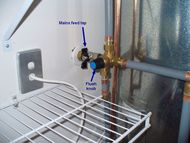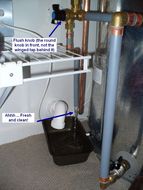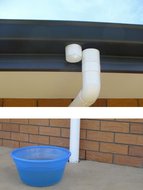Earthquake Update and How to use your Water Heater as a Reservoir
Status update and some thoughts
We hope this finds you well. Our thoughts and deepest sympathies are with all our fellow citizens of Christchurch and New Zealand who’ve been affected in some way by the recent major 6.3 earthquake in Christchurch.
Our families and close friends are unharmed, and we’ve sustained only minor damage to our buildings and property. Since our buildings are in the CBD, we’ll be working out of other offices temporarily. Our customers will be pleased to know that all our data, websites, and other services are backed up and fully operational from our Auckland-based servers.
We realize that many other Christchurch people & businesses have been affected in much more tragic ways. Without wanting to gloss over what is truly a sad situation, we believe the Christchurch situation is in God’s hands. We know that saying so doesn’t make it any less difficult for those who have lost friends, family members, and property. We want you know we’re praying for you.
Like everyone, we are doing what other things we can in order to help relieve burdens where possible.
How to use your water heater as a reservoir
We all know by now that lack of clean drinking water is one of the serious long-term hazards in an earthquake: the main water supply can be off or contaminated by the sewer. Here’s how to use your water cylinder as a reservoir of clean drinking water.
This will be of most use if your water is still off, because otherwise you’ll probably have some unclean water in your tank. The procedure may differ slightly for you, but the basics are here.
Click on the photos to the right to see more detail.
1. Turn off the feed immediately
 Turn off cylinder’s cold water feed as soon as you can after the quake. If you’re lucky, you’ve got a tap on the pipe coming out of the wall. Or if you have a header tank in your attic, the feed will be up there.
Turn off cylinder’s cold water feed as soon as you can after the quake. If you’re lucky, you’ve got a tap on the pipe coming out of the wall. Or if you have a header tank in your attic, the feed will be up there.
2. Find the flush outlet
 Find the “flush” or overflow drain outlet. In this case we had to unscrew bits of the plastic drain to reveal the end of the grey outlet pipe.
Find the “flush” or overflow drain outlet. In this case we had to unscrew bits of the plastic drain to reveal the end of the grey outlet pipe.
3. Pull up the air inlet valve and prop it up
 Before letting clean water out of the drain pipe, pull up the air inlet valve to let air into the top of the tank as water goes out the bottom. You need to find something to prop open the air inlet valve. If nothing is going into the top of the tank when you drain water out the bottom, then the water will slow and stop. (Otherwise it can apparently suck the liner off the inside of the tank.) If you’ve got a header tank in your attic that feeds your cylinder, then you won’t have an inlet valve and you don’t need to worry about this.
Before letting clean water out of the drain pipe, pull up the air inlet valve to let air into the top of the tank as water goes out the bottom. You need to find something to prop open the air inlet valve. If nothing is going into the top of the tank when you drain water out the bottom, then the water will slow and stop. (Otherwise it can apparently suck the liner off the inside of the tank.) If you’ve got a header tank in your attic that feeds your cylinder, then you won’t have an inlet valve and you don’t need to worry about this.
4. Find the flush knob
 Find the “flush” knob that leads to that drain pipe, and you should get hot water coming out. It’s clean! Use it sparingly: your neighbours might needs some, too. In this case, the flush knob happens to be marked “flush”. You might not be so lucky. Look for where you think the water might drain out. The flush mechanism is used by plumbers to drain your tank before they have to replace it.
Find the “flush” knob that leads to that drain pipe, and you should get hot water coming out. It’s clean! Use it sparingly: your neighbours might needs some, too. In this case, the flush knob happens to be marked “flush”. You might not be so lucky. Look for where you think the water might drain out. The flush mechanism is used by plumbers to drain your tank before they have to replace it.
5. Turn off the power
You might want to turn off your water heater’s electric switch so you can get some cold water out. It’s easier to heat water than to cool it.
6. Catch rainwater from your roof
 Simply find a way to detach the downpipe from where it enters the drain, and place a large container under it. Some down-pipes (like the one shown) can be disconnected without even a screwdriver just by popping the pipe out of the spout.
Simply find a way to detach the downpipe from where it enters the drain, and place a large container under it. Some down-pipes (like the one shown) can be disconnected without even a screwdriver just by popping the pipe out of the spout.
If you’re smart, you’ll probably find a way to channel your roof water into your header tank, but there’s no need to get fancy here: just use any large container you have handy.
Note:
Turning off the water feed is important so that you don’t let water from the main supply into your cylinder. This is because the water supply is potentially contaminated by broken sewer lines after an earthquake. If you want your water heater to retain clean water then be sure to turn off the feed before you draw any hot water out of your hot water taps. Because drawing hot water out of the tap will suck potentially cold water into the water heater. Don’t worry if you’ve just run a hot water tap briefly by accident: you’re probably just sucking in a bit of clean cold water that was still in your pipes. Some tanks don’t have a feed tap. If that’s true for you, then your hot water will only stay clean if your mains water supply is off and not feeding your tank.
Do you have any useful earthquake tips of your own?
2 March 2011 by Bryan 4 comments
4 comments (oldest first)
Hi Roel. No, we’re really talking about using the water heater tank itself. Not everyone has a header tank above their water heater tank, and this procedure may help them, too.
Good post! i love it, please bookmark this page in digg or mixx so that anyone could find it easily. :) Thanks for sharing this info. You guys have made a wonderful website
Interesting. I never actually imagined using the storage tank of my water heater as a reservoir during calamities. Thanks.
Your statement should read HEADER TANK